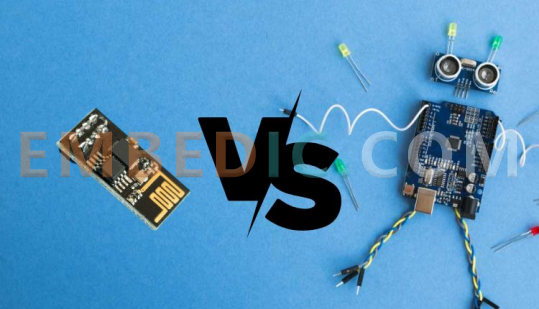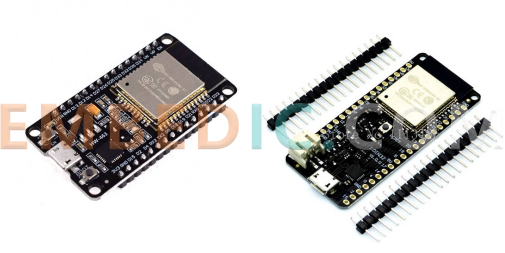The ESP32 and Arduino are two of the most popular development boards based on microcontrollers, significantly impacting embedded systems and DIY projects. While these boards share similarities in their operational principles, they exhibit notable differences in programming, hardware, processing capabilities, and various other factors.

Developed by Espressif Systems, the ESP32 development board boasts high performance and comes with built-in Wi-Fi and Bluetooth capabilities. On the other hand, Arduino development boards have gained popularity for their simplicity and widespread user community, making them a favored choice among educators and hobbyists. This article briefly outlines the distinctions between the ESP32 and Arduino boards.
Both ESP32 and Arduino microcontroller boards are well-known among researchers, students, and beginners as they can accept inputs and generate outputs without requiring additional hardware, such as a CPU, for data processing.
With compact dimensions, ESP32 and Arduino boards are easily portable and can fit into your pocket. Understanding the key differences between Arduino and ESP32 can assist you in choosing the right platform for your application.
ESP32 is a low-cost development board that supports WIFI and Bluetooth. With built-in wireless technology, these boards play an important role in developing IoT based projects. The board operates from 2.2v to 6v and provides a constant voltage and an output current of 500 mA through an on-board voltage regulator.The ESP32 development board contains a dual-core processor running independently of each other and 4MB of flash memory, which makes the board very fast.

Thanks to integrated Wi-Fi and Bluetooth, the development board is designed for cost-effective, energy-efficient and simple IoT-based applications and is built around a dual-core Tensilica Xtensa processor, 160 MHz frequency, SRAM - 520 KB, GPIO pins - 34 and more. The development board can be simply programmed using Arduino lDE, MicroPython, LuaESP-IDF, JavaScript, etc. The ESP32 has a wide operating temperature range of -40°C to 125°C.
Arduino is an open-source development board designed for building embedded designs, wearable devices, electronic products, IoT projects, and robots. These boards facilitate the development of a wide range of electronic projects and devices by allowing simple connections of various sensors and motors.
The Arduino board features an ATmega328P 8-bit microcontroller with 0 to 13 digital pins. These pins serve for digital input and output, with digital input used for reading data from devices and digital output for sending data from Arduino to devices.
The board operates at a voltage of 5V, consuming a current of 45 to 80mA, and a deep sleep mode that draws 35mA. It can be powered via USB connection or a 9V battery from a computer or power source. The Arduino board operates at a frequency of 16MHz, executing 16 million instructions per second.
Arduino boards are open source development boards used to build embedded designs, wearables, electronics, IoT projects and robots. These boards help in developing various electronic projects and devices by simply connecting various sensors and motors.
The Arduino board includes an ATmega328P 8-bit microcontroller with 0 to 13 digital pins. These pins are used for digital inputs and digital outputs, where digital inputs are used to read data from the device and digital outputs are used to send data from the Arduino to the device.
The board operates at 5v and consumes 45 to 80mA of current and 35mA during deep sleep.The board can be powered using a USB connection or a 9V battery from a computer or a power supply.The Arduino board operates at a frequency of 16MHz and thus executes 16 million instructions per second.
ESP32 and Arduino are two popular hardware platforms with distinct specifications, catering to a variety of applications. Let's delve into the differences between ESP32 and Arduino in terms of their processors, memory, I/O capabilities, wireless connectivity, and hardware architecture.
|
Feature |
Uno R4 Minima (Arduino) |
ESP32 |
|
Processor |
ARM Cortex-M4, 48 MHz |
Dual-core Xtensa LX6, 240 MHz |
|
Memory |
32 kB RAM, 256 kB flash, 8 kB data memory |
520 kB RAM, 4 MB flash (up to 16 MB) |
|
I/O Pins |
20 (14 digital GPIO, 6 analog input) |
32 |
|
Wireless Connectivity |
Wi-Fi extension or Arduino R4 Wi-Fi model |
Built-in Wi-Fi |
|
Hardware Architecture |
Microcontroller-based |
Dual-core processor, various peripherals |
|
Programming |
Arduino IDE (C, C++) |
Multiple languages (C, C++, Python) |
|
Use Cases |
Education, hobbyist projects |
IoT, smart home, industrial automation |
Processor:
Uno R4 Minima (Arduino): It employs the RA4M1 chip, featuring a 32-bit ARM Cortex-M4 processor with a clock frequency of 48 MHz.
ESP32: It is equipped with a dual-core 32-bit Xtensa LX6 processor running at a higher clock frequency of 240 MHz.
Memory:
Uno R4 Minima (Arduino): Offers 32 kB RAM for data storage during program execution, 256 kB flash memory for program storage, and 8 kB data memory for storing program data during power loss.
ESP32: Defaults to 520 kB RAM and 4 MB flash memory, with certain modules supporting up to 8 or 16 MB.
I/O:
Uno R4 Minima (Arduino): Features 20 I/O pins, with 14 dedicated to digital GPIO and an additional 6 for analog input.
ESP32: Boasts 32 I/O pins, providing greater flexibility for connecting various sensors and devices.
Wireless Connectivity:
Uno R4 Minima (Arduino): Can connect to Wi-Fi using an extension board or the Arduino R4 Wi-Fi model.
ESP32: Comes with built-in Wi-Fi capabilities, offering seamless connectivity.
Hardware Architecture:
ESP32: Developed by Espressif Systems, it incorporates a dual-core Xtensa LX6 processor, 520KB SRAM, and various peripheral interfaces, supporting Wi-Fi and Bluetooth for seamless connectivity.
Arduino: Utilizes various microcontrollers, with the popular Arduino Uno using the ATmega328 microcontroller, featuring 32KB flash memory, 2KB SRAM, and a moderate 16 MHz clock speed.
Software and Programming:
ESP32: Supports multiple programming languages such as C, C++, and Python, providing flexibility in development.
Arduino: Renowned for its simplicity, Arduino IDE supports C and C++, with compatibility for microPython, making it beginner-friendly with a vast community and extensive library support.
Use Cases:
ESP32: Ideal for advanced projects requiring higher processing power and connectivity, such as IoT devices, smart home applications, and industrial automation.
Arduino: Known for its simplicity, making it a preferred choice for educational purposes, artistic installations, and hobbyist projects.
In conclusion, the choice between ESP32 and Arduino depends on the specific requirements of the project, with ESP32 offering advanced features and capabilities, while Arduino excels in simplicity and accessibility.
Here is the video about esp32 and arduino,
ESP32 and Arduino are both widely used open source hardware platforms, and both have their own features and advantages.
For beginners, Arduino may be easier to get started.Arduino has an easy-to-learn programming language and development environment, as well as plenty of sample code and documentation available. It also has more introductory tutorials and a support community that provides a wealth of resources to help novices get started and develop projects.
In contrast, the ESP32 is a powerful development board with more features and extensibility, such as wireless communication modules like WiFi and Bluetooth.The ESP32 uses a more powerful processor and more memory, making it suitable for more complex tasks and projects. However, ESP32 features may be a bit complex for beginners and require some extra learning and understanding.
If you are a complete beginner and don't have much experience with programming and electronics, then the Arduino may be more suitable for you. If you want more functionality and expandability, or if you already have some programming and electronics knowledge, then the ESP32 might be more suitable. Whichever you choose, there are plenty of resources and support available to help you get started and learn.
Further Reading: ESP32 vs STM32, Which is Better and How to Choose 2023
In conclusion, the choice between ESP32 and Arduino ultimately depends on the user's specific needs, experience level, and project requirements. Arduino is an excellent choice for beginners due to its user-friendly programming environment, extensive documentation, and a supportive community. It is particularly well-suited for educational purposes and simpler projects.
On the other hand, the ESP32 offers advanced features, higher processing power, and built-in wireless capabilities, making it a preferred choice for more complex applications, such as IoT projects, smart home automation, and industrial applications. While it may have a steeper learning curve, the ESP32 provides greater flexibility and extensibility for those with prior programming and electronics knowledge.
In essence, Arduino is a fantastic starting point for those new to the world of microcontrollers and DIY projects, while the ESP32 caters to users seeking enhanced capabilities and connectivity options. Both platforms contribute significantly to the vibrant landscape of open-source hardware, empowering users to bring their creative ideas to life. Ultimately, the right choice depends on the individual's goals and preferences in their journey of exploration and innovation in the realm of embedded systems.
Further Reading:
ESP32 vs STM32, Which is Better and How to Choose 2023
ESP32 vs ESP8266, Which is Better and How to Choose?
RP2040 vs ESP32: Which Microcontroller is Best for Your Project 2023?
Manufacturer: Texas Instruments
IC DGTL MEDIA PROCESSOR 529FCBGA
Product Categories: DSP
Lifecycle:
RoHS:
Manufacturer: Texas Instruments
IC DSP FIXED-POINT 532FCBGA
Product Categories: DSP
Lifecycle:
RoHS:
Manufacturer: Analog Devices
IC DSP BLACKFIN 400MHZ 400CSBGA
Product Categories: DSP
Lifecycle:
RoHS:
Manufacturer: Texas Instruments
IC DSP FIX/FLOAT POINT 256BGA
Product Categories: DSP
Lifecycle:
RoHS:
Looking forward to your comment
Comment